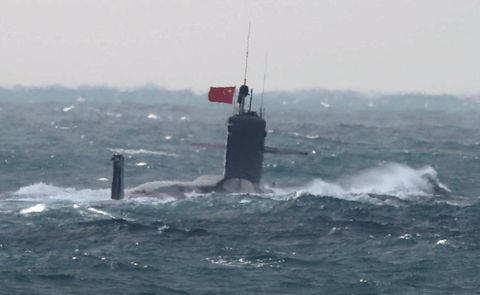Propulsion system can be heard on sonar. China submarine very low tech.
US is best UK France and Russia also good
https://www.popularmechanics.com/mi...as-nuclear-subs-too-noisy-for-their-own-good/
Are China’s Nuclear Subs Too Noisy for Their Own Good?
An incident in the East China Sea has observers wondering if China’s nuke boats have a noise problem.
BY
KYLE MIZOKAMI
JAN 29, 2018
JAPAN MINISTRY OF DEFENSE
Earlier this month, a Chinese nuclear-powered attack submarine surfaced in the East China Sea. The submarine, flying a huge Chinese flag, surfaced after being followed by Japanese naval forces. The incident raises a question: Are Chinese nuclear submarines too loud for their own good?
China’s People’s Liberation Army Navy operates between six and thirteen
Shang class nuclear attack submarines. Also known as the Type 093 class, the
Shang boats are 361 feet long, displace 7,716 tons of water submerged, and can dive to up to 2,296 feet. The submarines are powered by two pressurized water nuclear reactors, allowing them to make 30 knots submerged, and have six 533-millimeter torpedo tubes for anti-ship and anti-submarine attacks and vertical launch silos for land attack cruise missiles.
On January 12th, a
Shang-class submarine surfaced within the Exclusive Economic Zone around Japan’s Senkaku islands. (See image above.) The islands, which China claims and calls the Diaoyu islands, have been a bone of contention between the two countries since 2010. The two countries mostly enforce their competing claims by sailing coast guard vessels near the islands. This was the first time a submarine is known to have operated in the area.
The
South China Morning Post, in
an article on the incident, states the
Shang-class submarine involved in the incident had been followed for the previous two days by ships and aircraft of the Maritime Self Defense Force, Japan’s navy. The submarine operated submerged within 24 miles of the Senkaku islands, technically Japanese waters. It then moved out of Japanese waters, surfaced and proudly flew a large Chinese flag, and went home. The incident led the SCMP to ask whether the submarine surfaced because it had been detected or if the event was a publicity stunt on behalf of the Chinese government?
In the world of submarines, quietness is everything and can make the difference between being the hunter or the hunted. The
Shang class, according to Chinese sources, is about as quiet as the improved
Los Angeles class attack submarines, nuclear attack boats produced for the U.S. Navy between 1985 and 1996. The U.S. Office of Naval Intelligence estimates the
Shang is noisier than the Russian Victor III class submarines, 25 of which were produced between 1977 and 1991. Only four remain in service today, replaced by quieter, more modern designs.
Being only twenty years behind U.S. subs may not sound like a bad place to be, especially for a rising power like China, but the U.S. made some major advances in submarine quieting technology during the late 1980s and 1990s. The latest
Virginia class submarines are so quiet they’re described as “
quieter at 25 knots than the Los Angeles class at pierside.”
A Chinese Navy submarine in Hong Kong in 2004, flying a much smaller and more typically sized national flag than the one recently flown in the East China Sea.
The
SCMP’s experts are divided as to what caused the sub to surface, with some thinking it was intentional and others disagreeing. But clearly, if Japanese air and naval forces had been able to track the submarine for two days before the surfacing, the
Shang class is too noisy. A more suitable question might be, was it the Chinese government’s intention for the submarine to surface, or was the submarine forced to surface due to technical problems?
Either is a possibility, as China’s military is prone to excessively displays—such as flying an unusually large flag the first time a nuclear-powered submarine sails near the Senkaku/Diaoyu islands—and China’s military equipment, particularly complex systems, often don’t meet Western standards for safety and quality. In 2003, all 70 Chinese sailors aboard a Chinese diesel electric submarine
died during a training accident. The submarine reportedly drifted for days before a fishing boat came upon the lifeless vessel.
Regardless, the fact that Japanese forces were able to track China’s latest nuclear attack submarine continuously for two days does not exactly instill confidence in the submarine’s abilities. Still, a public failure like this does have an upside. As one
SCMP expert pointed out, “It’s not so bad that they’ve been exposed, it could push the Chinese to work harder on making the submarines quieter.” And China, which is in the middle of an unprecedented military modernization, is undoubtedly working on a design to replace the
Shang-class.



![The US accuses China of being the main source of illegal fentanyl, a charge Beijing rejects [File: Brian Snyder/Reuters] The US accuses China of being the main source of illegal fentanyl, a charge Beijing rejects [File: Brian Snyder/Reuters]](https://www.aljazeera.com/mritems/imagecache/mbdxxlarge/mritems/Images/2020/8/25/aee1552f86f94902858e4e0ccbef81b7_18.jpg)